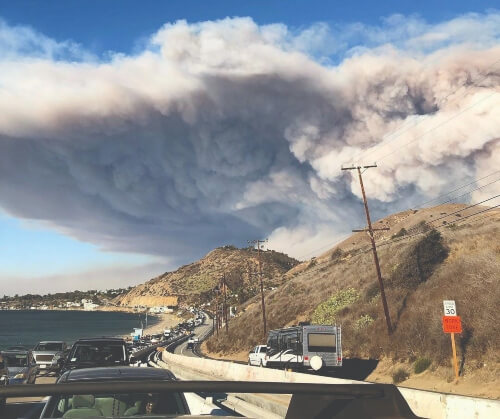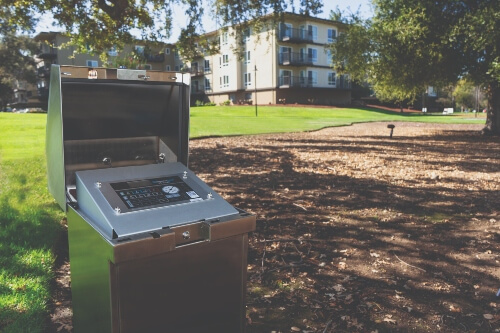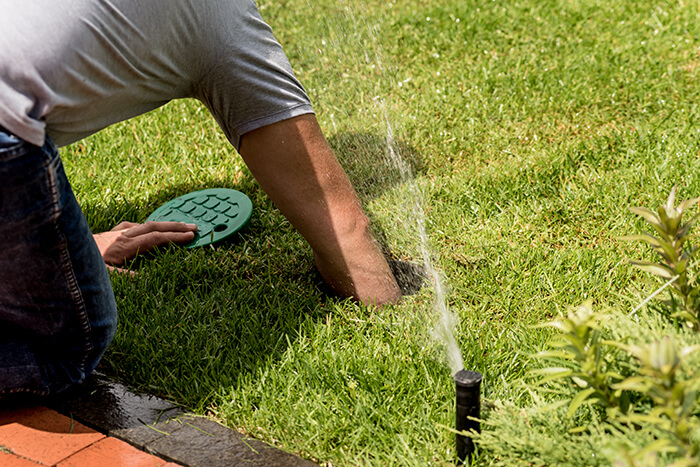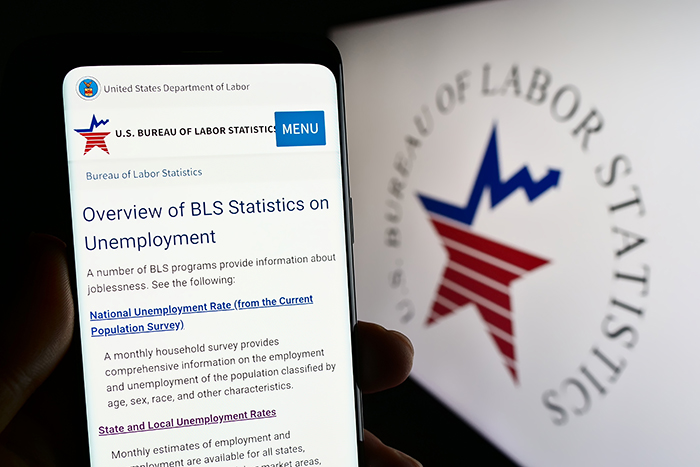We all remember the news reports of the devastating wildfires that ravaged California last year. Some people lost everything, their homes and everything in them, as the fires ripped through. Those were the lucky ones; many others lost their lives.
Sadly, it seems that infernos like these are becoming more frequent. As sizzling summer temperatures settle in across the country, many are wondering if this year will prove just as devastating.
For homeowners it can be scary enough just getting themselves and their loved ones to safety — the last thing they’re probably thinking about is whether their landscapes are going to survive. But in November 2018, during the Woolsey Fire that burned nearly 97,000 acres in Los Angeles and Ventura counties, one irrigation technician had customers on his mind.
SiteOne Landscape Supply LLC Technician T.J. Raden services customers in Central and Southern California. He estimates he has access to some 2,000 irrigation controllers and helps facilitate repairs on them. One of these systems is located on a private residence in Malibu. The 10-acre property near the Pacific Coast Highway has 98 irrigation stations watering trees, tropical plants, an orchard and a vegetable garden. As the Woolsey Fire encroached ever closer to the property, Raden sprang into action.
“When all of this first started, I actually couldn’t get a hold of the customer. So I just went ahead and used the mobile app to start a manual cycle and decided, ‘let’s just put some water down and see what happens,’” he said.

A large smoke plume from the Woolsey Fire encroaches on Malibu Nov. 9, 2018, as residents evacuate.
A couple of hours later, the owners called back saying they were in agreement with Raden’s strategy. He tried to restart the program but the property had lost power. “In the event of no power the controllers no longer work, so at that point I said, ‘I know if I write a schedule and a program, that program will automatically resume when the power is restored.’ The manual irrigation won’t start but the automatic program will, so that’s how we were able to get by.”
Within the first hour he had a program written that would run the 12 sprinklers that water the hillside. Not only do the sprinklers keep it watered, they serve as fire sprinklers. “It’s essentially a combination of impact sprinklers on risers that water the hillside and keep it green. Well, you can also use them to keep the hillside extra, extra green,” Raden says.
He set up the 12 valves to run 5 minutes apiece. He also set a 60-minute soak time for each valve. Essentially the program would run one of the valves at every minute of the day as long as there was power.
“If power went out, we would lose all water, but as soon as power came back on, we would automatically resume,” Raden says.
The irrigation controller and mobile app he was using, WeatherTRAK ET Pro3 from Petaluma, California-based HydroPoint, allowed him to view a live snapshot of what was going on at the property. As the fire grew closer, Raden was able to see how much water was flowing. He determined he could run a program and do a manual watering simultaneously. “At that point I was able to put double the amount of water down and still not max out the main line,” he says.
The Woolsey Fire burned for a good week and a half before it was finally suppressed. It followed an erratic path, coming within a half-mile of the house but never making it all the way.
It’s hard to say how that watering would have fared if the flames did reach the property, but, “We had no embers jump, no spot fires, so I consider that a win in my book,” says Raden. Needless to say, the homeowners were quite thankful for Raden’s ingenuity.
A growing need
Sean Penn, HydroPoint’s vice president of product management, commends Raden for his efforts that day. Although smart irrigation controllers are not specifically designed to prevent fires, they do create a healthy landscape that is more resistant to them.
“HydroPoint has been focusing on water savings for 17 years but that’s always balanced with making sure that an irrigated landscape is well-maintained, that you don’t have zones that are too dry,” he says. “You want to get enough water down to keep the plants healthy and to keep the ground at the water level it needs to be to prevent damage to the plants, which also helps with fire prevention. It’s just making sure that plants will be healthy by applying the right amount of water at the right time.”

For any homeowner or commercial property owner thinking about creating a fire-conscious-landscape, Penn advises keeping it well maintained with built-in breaks and defensible perimeters. While he doesn’t endorse one type of landscape over another, he says a lush landscape likely has more success surviving a fire event than a xeriscape would, though xeriscaping is important as droughts become more frequent. When xeriscaping, defensible perimeters become even more important as do flame-resistant plants and shrubs.
Keeping plants watered as a fire prevention strategy is a pretty straightforward concept. “It’s a simple fact that a living tree burns slower than a dead tree will,” Raden says.
Steve Counter, vice president of category management at SiteOne agrees, saying, “Irrigated landscapes, including turfgrass and trees, provide a cooling effect by reducing the surrounding air temperature, providing shade and minimizing dust.”
And there’s other benefits. “They also have a positive impact on property values and overall aesthetics. An irrigated landscape can also provide a mini wildlife refuge for birds and other animals,” he adds.
To ensure that all parts of a landscape are getting the water they need, many smart irrigation controllers, including HydroPoint’s, have the ability to send alerts that keep users informed about what is happening on their properties.
“If you get a flow or electrical alert, it means something is wrong with the station, such as a bad wire or broken head, so the zone may not be receiving proper irrigation,” says Penn.
Associated apps and web portals allow technicians and customers access to their systems from anywhere to address issues as soon as they arise. “That remote management aspect is what keeps those properties well-maintained and also gives you the fire prevention element for your landscape,” he adds.
Drought-defying and responsible
If it wasn’t for drought and dry conditions, wildfires like the Woolsey blaze would not have become huge, out-of-control disasters. As dry, droughty conditions can pop up anywhere in the country at any time, irrigation customers are wanting to make sure they’re irrigating not just responsibly but adequately.
“It’s all dependent on the weather,” says Counter. “Four years ago, Texas went through a severe drought and there was a lot of interest [in smart irrigation] there. Before that it was the Southeast — and then there was California two years ago. It’s so dependent on what that regional weather pattern is, but we know there are markets like the Southwest that are always drier than other areas like the Southeast.”
Because no one knows for certain when or where the next drought will hit, Counter advises all irrigation contractors to be prepared. “It benefits them to understand the opportunities that smart controllers and high-efficiency systems provide from a water- savings standpoint, as well as their other potential benefits, such as the reduced risk of fire.”
But the main driver for smart irrigation controllers is savings. “If you can show homeowners that there is a savings associated with having a high-efficiency system, it will be an easy sell,” says Counter.
You can even show homeowners the exact amount of water they’ll save. Companies like Hunter, Rain Bird, Toro and others can calculate the savings someone would realize with a system upgrade based on current water usage, Counter says.
Staying compliant
The compliance management feature of smart controllers is becoming a big benefit for those wanting to make sure they are following the rules. “We actually pull in all the information from the local water agency about your watering restrictions and can create alerts that will warn you if you’re violating any of those restrictions,” says Penn.
Several manufacturers provide this same service. Penn says the WeatherTRAK has been easy for users to learn. “After a short 10-minute run-through, users can do what they need to do. That is a big plus.”There are situations where he prefers using other manufacturers’ controllers — it all depends.
Remote access is an essential part of efficient irrigation, according to Raden. He’s seen some of the properties he services trying to cover way too much territory manually. “I’m sorry, but one guy is not going to be able to physically walk around and check 100 or 200 valves once a week. It’s just too much work.” An app that lets you see which valves aren’t opening, aren’t working or are flowing too much “makes life so much easier for us in the industry,” he says.
What about the water delivery itself? Counter recommends in drought situations to think high-efficiency. “Suggest low-volume or drip irrigation for nonturf applications and 6-inch pop-up heads with stream rotor nozzles for turf on smaller properties.
Precision irrigation is becoming more critical in the face of increasing water restrictions, while there’s also a need to mitigate the effects of drought and dryness. Irrigation contractors must do a balancing act between these competing objectives. Advanced flow management technology can help.
“People are starting to pay attention to it, realizing that they can’t get all the water they need down on all of their landscape within their specified watering window, so they are going to have zones that are dry or dying, and they may have to replace plants,” Penn says. “Advanced flow management looks at how much hydraulic capacity your system can handle, how many gallons per minute it can pump through those pipes. Then it will turn on as many stations as you can have on at one time in order to reduce the duration of that irrigation cycle.”
Penn says HydroPoint is well positioned for the future of irrigation. “I think we are pretty optimized already in terms of getting the right amount of water down at the right time, so it comes down to helping customers as they change the way they handle their water supply to be able to accommodate that. For example, the use of graywater or reclaimed water will be increasing in the future, and we want to be able to help them manage those multiple water sources.”
Soon technology will allow very recent satellite imagery or drones that will allow a customer to see how a property is faring from a stress standpoint, Penn predicts. “It is already being used in agriculture and could be used for commercial property owners as well to determine how much water needs to be added.”
As more systems become connected, Penn says more coordination with emergency services will be possible.
As droughts and fires become more commonplace and water use becomes more regulated, irrigation must continue to advance. The old adage of working smarter and not harder not only applies to people, it also applies to irrigation.





